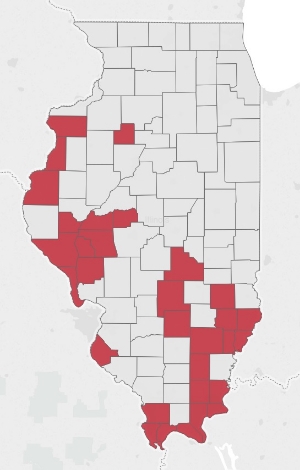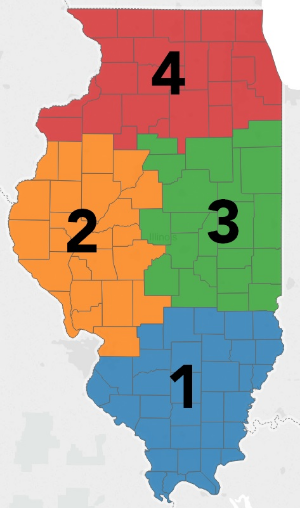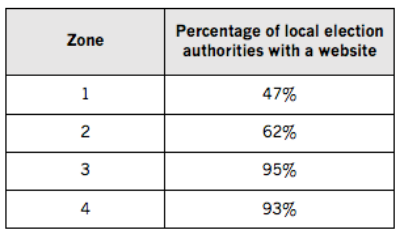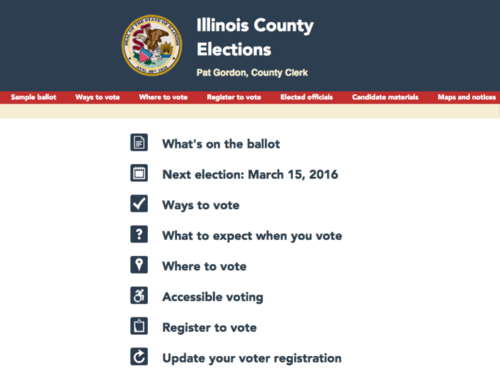Nearly a Third of Illinois Counties Have No Election Website
Illinois — known as the Land of Lincoln, the Prairie State, and the home of the Third Coast — is frequently described as a bellwether for American culture, as a microcosm of the nation as a whole. There are good reasons to believe that’s true. With Chicago, Illinois has the third largest city in the country, but it also has more soybean fields than almost anywhere. And while the state’s urban north stands as a bastion of liberal politics, counties downstate are reliably conservative in their voting patterns.
In fact, when it comes to voting, there’s another way in which Illinois is representative of the country overall: the presence – and absence – of local election websites.
For their 2012 report “Usability of County Election Websites,” Harrell, et. al. studied a nationwide sample of local election websites and found that although voters are looking for election information online, about a third of county election offices (31.6%) don’t have a website. We wanted to discover how this dynamic is playing out in Illinois. Is a lack of election websites a problem for Illinoisans?
Our method
We started by looking through the list of local election authorities maintained by the Illinois State Board of Elections. If the state SBE provided a URL for the authority, we followed it, but we also did an internet search for each authority to see if any new websites had emerged since the SBE created its list. For our search, we used Google, the most used search engine in the U.S., entering in terms like “_______ County, Illinois elections.”
We found that some election offices have excellent websites, while others have minimalist ones. In some cases, we found that a county in question has a general county website but isn’t providing election information on it. In other cases, we found no web presence at all.
All told, we concluded that 31 of the 110 authorities in Illinois lack any website that provides election information. This figure – which amounts to 28.2% — is quite close to what Harrell, et. al. found in their 2012 national study. Below is a map showing the counties without websites.

To better understand what’s happening, we broke the issue down by region, income, and population. For whom is not being able to access an election website a problem? And why?
Region matters
Between Chicagoland, the Quad Cities, the central prairie, and Little Egypt, Illinois is a state of several different regions, each with its own culture and its own set of resources and challenges.
Unfortunately, we found that the quality and quantity of civic information has a regional bias. In other words, searching for an election website in vain is an experience that’s not distributed evenly across the Prairie State. When it comes to creating and maintaining local election websites, some parts of the state are doing excellently, while others rate as poor.

Illinois’s 110 local election authorities – its 102 counties plus 8 municipal offices – are divided up into 4 regional zones corresponding to north, south, east, and west. We found that civic information online is much more plentiful in the northern and eastern regions of the state than in the western and southern portions. The biggest contrast is between Zone 3, where nearly all (95%) election offices have a website, and Zone 1, where not even half (47%) do.

It seems clear that many local election authorities in Zones 1 and 2 have a long way to go to close the gap with Zones 3 and 4. But the challenge is not merely one of initiative or determination. Instead, financial resources and population seem to play a role.
Money matters
While there are multiple factors behind the strength or weakness of local civic information efforts, one of the most significant ones seems to be wealth. Zones 1 and 2, which have much room for improvement when it comes to publishing election websites, also have lower median incomes than do Zones 3 and 4, where penetration of election websites is almost complete.

In addition, among the twenty wealthiest counties, only two local election authorities (10%) lack a website, whereas among the twenty counties with the lowest median incomes, eleven (55%) have no election information online.
Population matters
The problem is not just due to resources or wealth, though. Actually, population seems to play an even more significant role. Of the twenty least populous counties in Illinois, 15 (75%) do not have websites. On the other hand, of the twenty most populous, 20 (100%) have a website. In other words, counties with smaller populations seem much less likely to publish election material online than more populous ones.
Overall, the population figures mirror the ones that Harrell, et. al. found. They noted that “although 966 jurisdictions did not have websites, 94% of Americans live in a county where there is an official website that provides election information.”
We found that 3.4% of the Illinois population lives in a county without an election website. That may not sound like a lot, but that’s 439,727 people. To put that into perspective, that’s approximately the population of Raleigh, North Carolina or Miami, Florida.
Though they’re mostly small, these 31 counties matter. We believe they should be able to have an election website that they’re proud of, that serves their community, and that helps to promote civic engagement among their citizens.
Conclusion
Overall, our research on Illinois’s 110 local election authorities and their website status shows that Illinois is emblematic of the problems with civic information throughout the U.S. But just as Illinois is a microcosm for the nation, it might also provide a model for spearheading change.
To help set change into motion, we’ve designed an election website template that’s specifically designed for the needs of Illinois counties. The template comes ready with language on Illinois election law, on the state’s process for voter registration, and so on. It also includes Illinois election website posting requirements.

The template is envisioned as a starting point to help counties in the state who don’t have a website. Check out the website template and let us know what you think!
To inquire about the template or our Illinois election research, reach out to CTCL’s Government Services Associate, Kurt Sampsel, at [email protected].